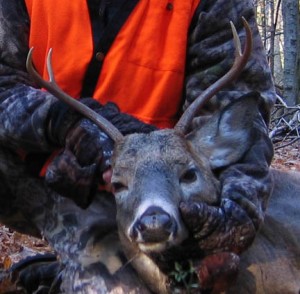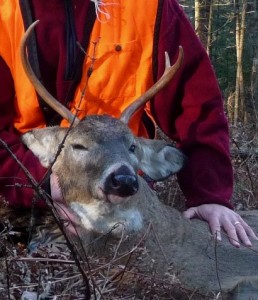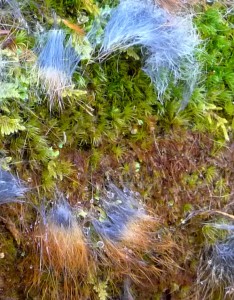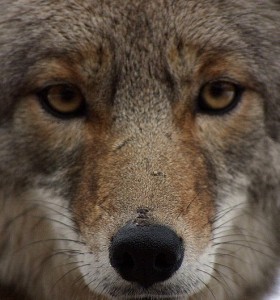We conserve and protect what we care about. If we don’t care much, where in our hearts can a serious conservation ethic possibly take root?
Tag: wildlife
Eating and caring: The lines we draw
I think everyone holds some version of the same conceptual category: “Fellow creatures about whom I care too much to eat.”
Accounting for taste: What’s with “gamey”?
 Just before the New Year, I was talking with a hunter I know. He mentioned how much he enjoys preparing venison for non-hunters. So often, they’re surprised by how good it tastes. Only one thing bothers him. After they declare it to be delicious, they’ll say, “I expected it to be gamey.”
Just before the New Year, I was talking with a hunter I know. He mentioned how much he enjoys preparing venison for non-hunters. So often, they’re surprised by how good it tastes. Only one thing bothers him. After they declare it to be delicious, they’ll say, “I expected it to be gamey.”
“I’m so tired of people saying they expect it to be ‘gamey,’” he told me. “Venison is about the nicest meat I can imagine.”
A few nights later, a couple of friends were here at our place for dinner. Among the dishes on the table was a bowl of venison meatballs. I told one of our guests how fond Cath is of that particular recipe. “Oh,” he asked, “does it help get the gamey flavor out?”
The gamey flavor. What is with that?
Is this notion stuck in people’s heads because they’re freaked out by the idea of eating wild animals? Is it rooted in cultural and economic history, in the feeling that game-consumption is a sign of poverty?
Are people speaking from experience? Have they been subjected to horrendous cooking? Have they been traumatized by eating venison that was poorly processed, or was “aged” until it turned green? (For a not-so-scientific investigation into the effects of such handling, see “The Taste Controversy Ends” from the U.S. Venison Council.)
I don’t know. Maybe it’s just me. Maybe, in my decade as a vegan, I simply forgot what domestic meat tastes like.
Cath and I do eat plenty of local chicken and turkey, but when it comes to red meat, venison is the only flavor I really know. When the weather warms, I’ll be slicing thin strips of backstrap, sautéing them lightly, and serving them over fresh salad greens from the garden. Cooking venison this way doesn’t get rid of any of the flavor, thankfully.
Maybe there’s nothing wrong with beef, but I expect it might taste farmy.
© 2011 Tovar Cerulli
Adult-onset hunting: Know the signs
 Experts have not yet determined whether Adult-Onset Hunting™ (AOH) is an epidemic. What they do know is that thousands of people are afflicted.
Experts have not yet determined whether Adult-Onset Hunting™ (AOH) is an epidemic. What they do know is that thousands of people are afflicted.
 More than a year ago, it was known—and reported in a widely read New York Times article—that a growing number of U.S. citizens had the condition. According to a recent article in Toronto’s National Post, a number of Canadian citizens have contracted it as well. The geographic epicenter is unknown. Though early reports suggested that AOH is most commonly contracted in cities, recent research indicates that it is even more virulent in rural areas.
More than a year ago, it was known—and reported in a widely read New York Times article—that a growing number of U.S. citizens had the condition. According to a recent article in Toronto’s National Post, a number of Canadian citizens have contracted it as well. The geographic epicenter is unknown. Though early reports suggested that AOH is most commonly contracted in cities, recent research indicates that it is even more virulent in rural areas.
Experts suspect that AOH may have lain dormant in the American psyche for generations, feeding off 19th-century stories about Daniel Boone.
 The most recent outbreak appears to be a mutation, triggered in part by widespread interest in knowing more about one’s food sources than is psychologically healthy. One pathological example often cited by both experts and adult-onset hunters is journalist Michael Pollan’s twin desires to visit cattle feedlots and to shoot a wild pig.
The most recent outbreak appears to be a mutation, triggered in part by widespread interest in knowing more about one’s food sources than is psychologically healthy. One pathological example often cited by both experts and adult-onset hunters is journalist Michael Pollan’s twin desires to visit cattle feedlots and to shoot a wild pig.
When fully developed, the primary symptoms of AOH are unmistakable: an otherwise normal, heretofore-non-hunting adult repeatedly goes to woods, fields, or marshes with a deadly implement in hand, intent on killing a wild animal.
Other potential symptoms include (1) a feeling of connection to nature, to one’s food, and to one’s hunter-gatherer ancestors, and (2) a re-calibration of one’s beliefs about hunting. Previous beliefs may suffer from atrophy, seizures, and even death, especially when an anti-hunter contracts AOH.
Knowing the early warning signs may protect you or a loved one from the worst effects. These early signs include:
- Excessive reading about the production of industrial food, especially factory meat.
- Esophageal spasms upon learning that the average pound of supermarket ground chuck contains meat from several dozen animals slaughtered in five different states.
 Sudden bouts of wondering why the local food co-op—with its cooler full of local, organic, free-range meats—doesn’t sell hunting licenses.
Sudden bouts of wondering why the local food co-op—with its cooler full of local, organic, free-range meats—doesn’t sell hunting licenses.- Compulsive eating of “real food” purchased directly from farmers.
- Recurrent realizations that farmers are killing deer and woodchucks to keep organic greens on your plate.
- Impaired ability to find meaning in chicken nuggets or tofu dogs.
- Insistence on a literal reading of Woody Allen’s dictum “Nature is like an enormous restaurant.”
- An uncharacteristic compulsion to initiate dinner conversation about firearms.
- Impaired ability to see humans as separate from the rest of nature.
- Repeated contact with real, live hunters (experts suspect that AOH is highly contagious, though transmission mechanisms are not yet fully understood).
Early diagnosis is problematic, as other potential warning signs include interests in hiking, gardening, fishing, mushroom hunting, raising chickens, cooking, and eating. Even vegetarianism can be a precursor condition, particularly if your acupuncturist has recommended that you add animal protein to your diet.
Alarmingly, growing up in a non-hunting or anti-hunting family does not guarantee immunity.
Experts have begun searching for a genetic marker indicating a predisposition for AOH. Until an accurate test is available, researchers recommend following these guidelines:
- If you or someone you know exhibits 0-3 of the above signs, the risk of adult-onset hunting may be low. You are urged to watch for further symptoms.
- If 4-6 of the above signs are present, immediate action is required to prevent a full-blown case of AOH. Recommended precautions include (A) obstinate refusal to think about where one’s food comes from, especially any meat consumed, and (B) at least one-half hour per day of reading about how humans are, in fact, extraterrestrials.
- If 7-10 of the above signs are exhibited, adult-onset hunting is already entrenched. Primary symptoms will begin to appear in a matter of weeks. Sign up for a hunter education course as soon as possible and find a hunter willing to show you the ropes.
There is no known cure.
© 2011 Tovar Cerulli
Venison: Lean, clean, and (no longer) lead-fortified
I disposed of the lead fragment and picked through the rest of the venison carefully. I hoped none of my bullets would ever come apart like that again.
Zen and the art of deer hunting
 Don’t try too hard, some folks say. Desperation can drive the deer away. The less you expect, the more animals you see.
Don’t try too hard, some folks say. Desperation can drive the deer away. The less you expect, the more animals you see.
How this philosophy dovetails with the undeniable value of perseverance, I’m not sure. But there may be something to it.
In my first few years as a hunter, I dragged home exactly zero pounds of venison. It was only in my fourth autumn—after I gave up on getting a deer and decided to focus on just enjoying my time in the woods—that my first buck came along.
The next year, I had no expectation of repeated success so soon. Yet a deer came. The year after that, with less time to hunt, my expectations were even lower. Again, a deer came.
There are limits to such luck, however.
This fall, I would be too busy to spend much time in the woods. (Of late, I’ve been too busy even to spend much time in the wilds of the internet. As fellow bloggers can attest, my forays there have left few traces in the form of comments.) I felt sure our freezer would hold no venison this winter. But I promised myself I would get out for a few mornings, just to feel the forest wake at dawn.
A week ago, on opening morning of rifle season, I was doing just that. I had reached the woods a full hour before sunrise: half an hour before legal shooting light.
In the dark, I heard one deer somewhere behind me, its hooves crunching leaves. But its meandering, start-and-stop movements sounded more like a doe browsing than a buck seeking a mate. Here in Vermont, only the latter are legal game in rifle season. Slowly, the animal wandered out of earshot. Probably the only deer I would hear that morning.
No matter. My aim, as meditation teachers say, was to “just sit.” And, as woodland deer hunters say when the leaves are that dry and frosty, to “just listen.”
The rustle of a leaf.
The swishing of wings, as a pileated woodpecker moved from one tree to another.
The sounds of the forest breathing.
I can’t recall ever taking so much pleasure in simply sitting, eyes closed. My mind went still, letting go of its churning thoughts about the next chapter I would be drafting for my book, or about the research I’m doing in grad school, interviewing hunters who came to the pursuit as adults. I was hardly even thinking about deer.
I had been there an hour, listening, when the hoof steps came, moving not into the faint breeze, but with it, so that the animal’s scent was carried my way, rather than vice versa. Again, the sounds stopped and started.
A doe, I thought, maybe the same one.
But when the deer stepped into view, just ten yards off to my right and behind me, I saw antler. And—more surprising—I made out a pair of points on one side. A legal buck.
I saw, too, why the animal’s movements sounded sporadic. The buck was so hopped up on rut-time hormones that he could hardly take a step without stopping to hook a sapling with his antlers or to paw at the earth.
A few more steps, as the buck crossed behind me. An ambling turn that would take him away, yet gave me the chance to raise my rifle unseen. A clear view as he angled off. A moment’s pressure on the trigger.
 Crouching beside him, I offered thanks and apology—poor compensation for what I had taken—and thought how strange this brief hunt had been. In years past, I had never even seen a buck on opening day.
Crouching beside him, I offered thanks and apology—poor compensation for what I had taken—and thought how strange this brief hunt had been. In years past, I had never even seen a buck on opening day.
The next morning, returning scraps to the forest, I paused by a pair of crisscrossed logs. The moss was festooned with clumps of fine, downy fuzz. Puzzled, I leaned over to look more closely.
Red squirrel. The ephemeral traces of another, winged, hunter’s kill.
© 2010 Tovar Cerulli
Coyotes, deer, and the very idea of ‘game’

A few nights ago, coyotes yipped and howled nearby. I was delighted to hear them.
Granted, I was in bed at the time. My sentiments would, I suspect, be substantially different if I was, say, deep in the woods with a turned ankle and no flashlight.
The next day I got thinking about those wild yelps, and about coyotes.
Here in Vermont, some hunters are happy to have coyotes around, and never think of killing them. Other hunters despise coyotes and shoot them at every opportunity. Still others are somewhere in the middle: perhaps ambivalent, perhaps hunting them occasionally, perhaps happy to co-exist as long as Fido and Sylvester aren’t getting snatched from the backyard.
These hunters would, I imagine, respond in various ways to Aldo Leopold’s thoughts about predators on the land:
Harmony with land is like harmony with a friend; you cannot cherish his right hand and chop off his left. That is to say, you cannot love game and hate predators; you cannot conserve the waters and waste the ranges; you cannot build the forest and mine the farm. The land is one organism.

What catches my eye in that passage is the word “game.”
As a broad category, of course, it simply indicates creatures that we hunt or catch. “Game” says deer, not shrew. It says grouse, not egret. It says bass, not minnow.
But doesn’t it also say something else?
By saying “game,” don’t we stake some kind of claim on these creatures? Don’t we define them as somehow different from other “wildlife,” perhaps one step closer to “livestock,” to “property”?
When hunters talk about what impact coyotes do or don’t have on white-tailed deer numbers, isn’t the entire discussion built on the very idea of “game”? On the notion that deer—almost like cows and sheep, or Fido and Sylvester—are, at least in part, off-limits to coyotes?
What are the consequences of believing that certain wild animals should be killed and eaten only—or at least mostly—by two-footed predators, not four-footed?
© 2010 Tovar Cerulli
